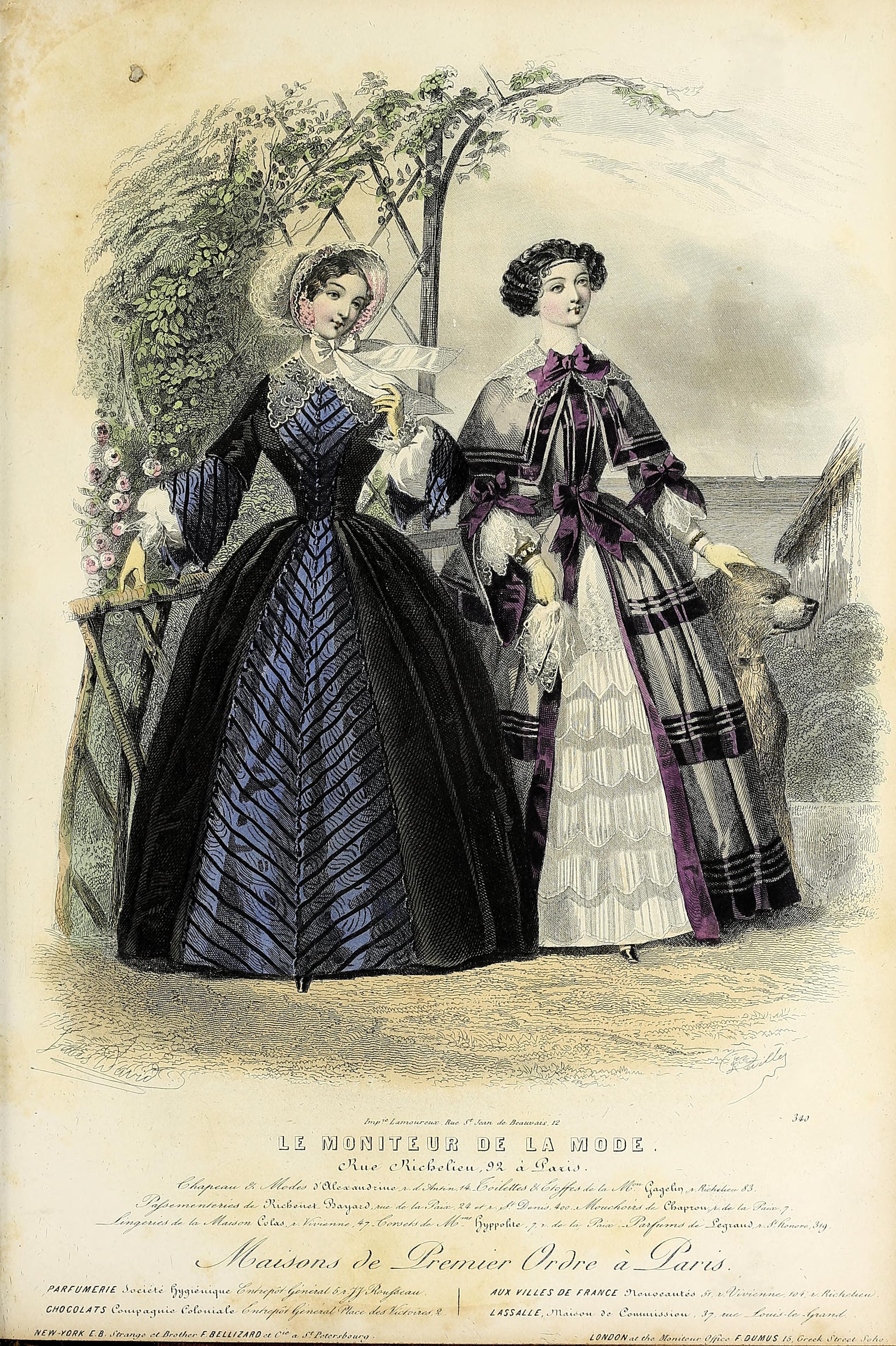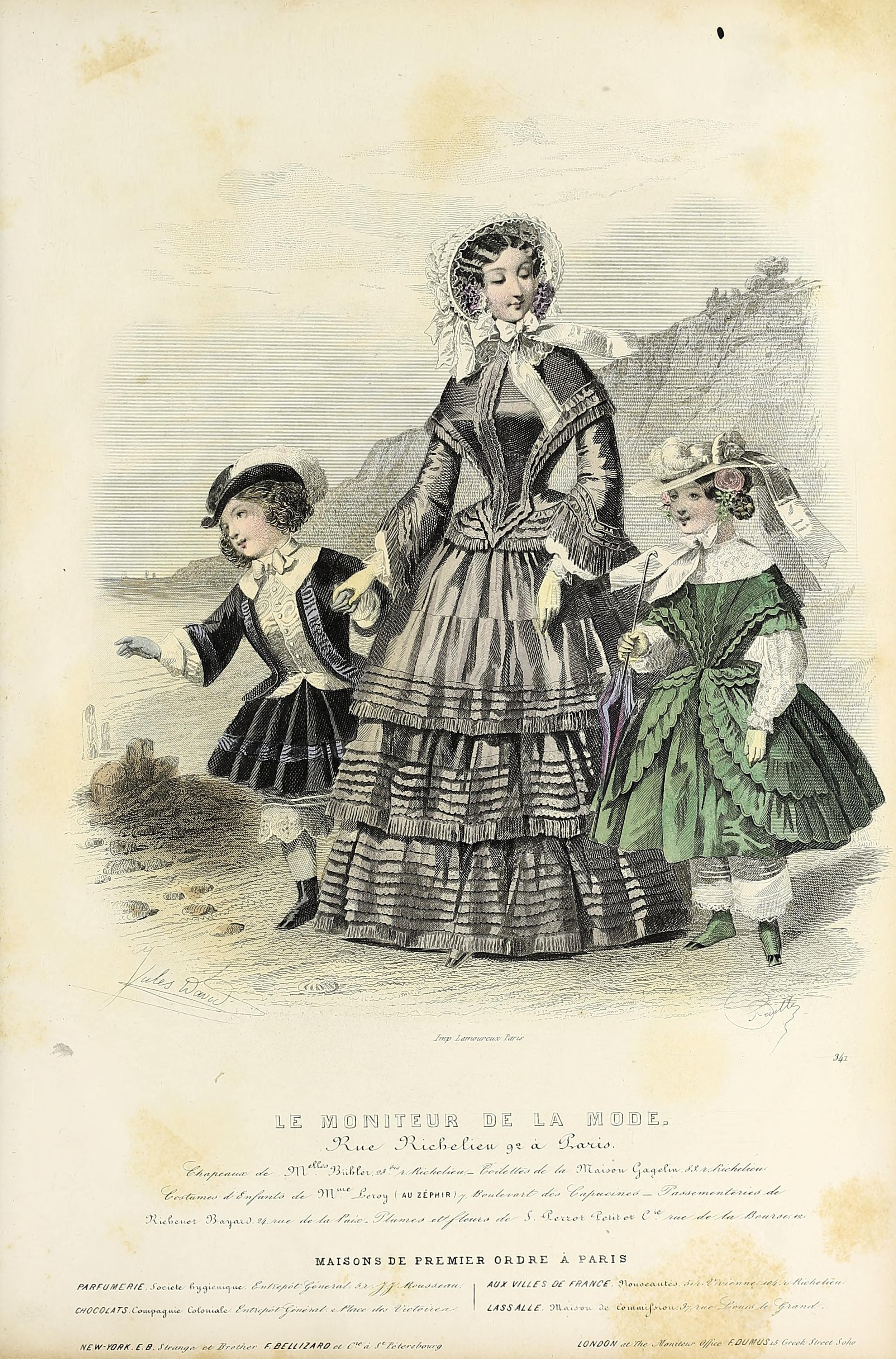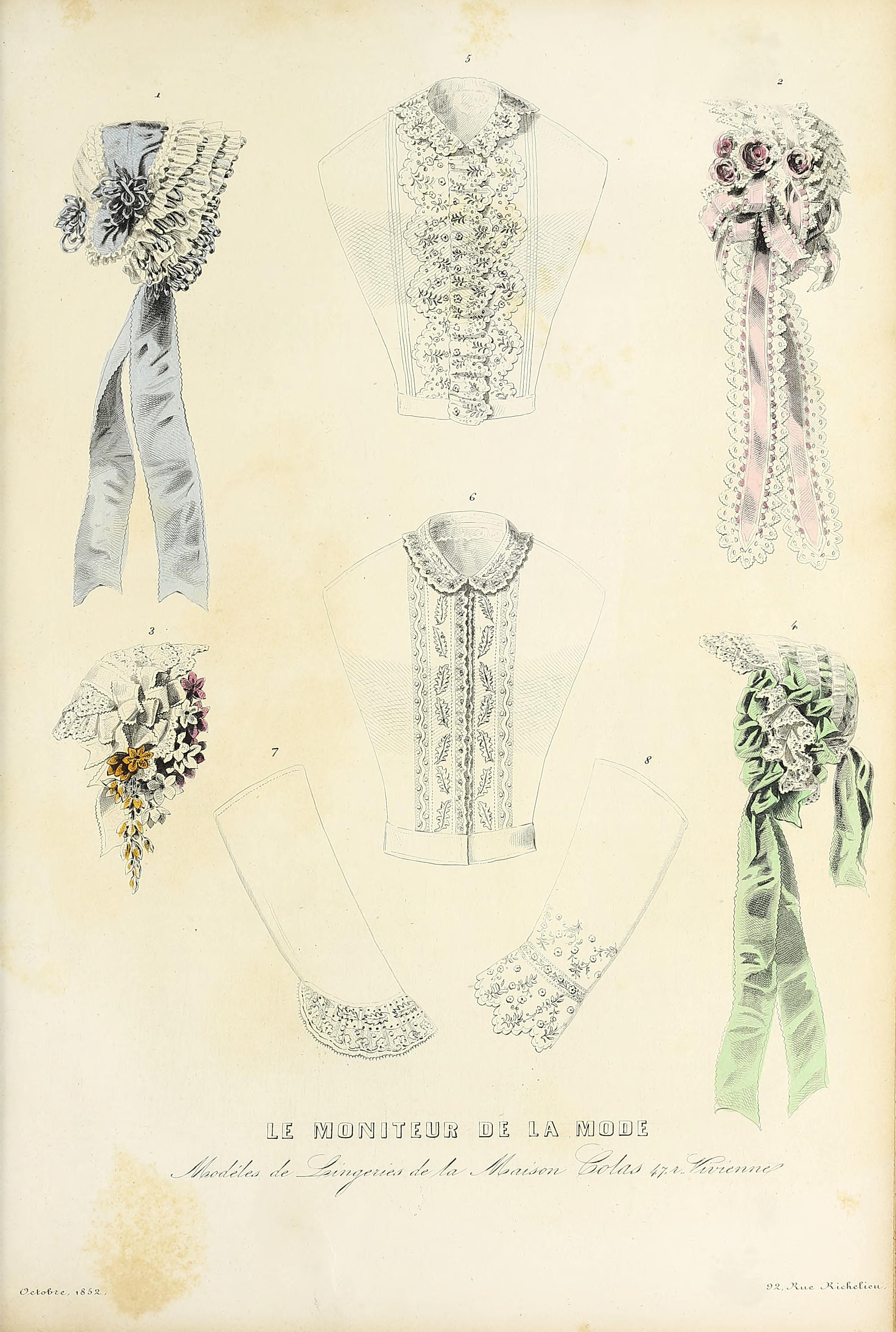No 10.—OCTOBER 1852.
The grand novelty at Delisle’s for out-of-door winter garments is a new tissue, stronger than cloth, as supple as cashmere, and as soft and silky as velvet. It is called ouatine. This splendid article is destined to one of those immense successes which mark an epoch. Ouatine is made of every possible shade, but of three different patterns only the small chiné , the great chiné, and the striped chiné. On account of its thickness, it is adapted only to full and loose garments, such as :
l. The Montmorency, a large cape without any seam, and having only a single opening at the sides to let out the arms.
The hood is round , flat, and has a gathered revers.
2 The Frileuse, having a skirt cut slanting, coming on the arm and forming a sleeve. At the top of the skirt is a plain pelerine, ending at the bend of the arm, and showing the fulness better.
3. The Tancred, very full in the back, with wide sleeves beginning at the elbow, and very wide openings, assuming the shape of a stole towards the bottom of the mantle.
A great square collar, fastening in front, gives the Tancred a historical character.
4. The Syberian, a large travelling cloak, coming almost as low as the dress, having an immense cape forming a round sleeve.
The ornaments of these different models consist of velvet bands at different heights, or in series, or as borders; of velvet cut from the piece, 6 inches wide, and stamped with patterns forming embroidery in relief; of a chiné plush ribbon, black and white, edged with velvet, either green, blue, or violet. The velvet should be of a colour contrasting with the stuff. The lining is silk and always matches the colour of the velvet. After the ouatine, come similar garments made of velvet and cloth, which surpass in taste, elegance and distinction those we had last year. Among the prettiest I will mention :
The Camargo of maroon velvet representing a square mantle, with sleeves also square, concealed by the trimming composed of a satin ruche with a narrow lace on each side of it. The Camargo is decorated with two flounces of very rich guipure. The first is six inches deep, the second twelve inches.
The Rob-Roy, of black velvet rounded off in front, and hollowed on square fronts, put on with concealed seams. A large collar, 12 inches wide, and square in front, gives the Rob-Roy an aristocratic appearance. It is trimmed with a galloon nearly three inches wide. Ground, satin and black reps, flowered with a double wreath of green bouquets. The lining is green satin. The galloon on the collar is much narrower. The Rob-Roy will he the favourite garment of our aristocratic dames.
The Princess Matilda, of blue velvet, having a kind of simulated cape ornamented with fringe reaching to the middle of the arm. Below this cape the skirt hangs in flutes. Two rich clasps fasten this little cloak with true Parisian simplicity.
The Charles IX, of violet velvet, with a flat hood, open on the, shoulders, trimmed with a guipure fringe, and simulating a tippet. This garment turns back in its fulness on added fronts, which represent Medicis sleeves. On one side only the violet satin lining is visible. The Empress, forming a straight basquine very short, of ruby-coloured velvet, veiled by a splendid Chantilly flounce 24 inches deep, reaching from about 4 inches below the neck to a little lower than the waist. At the edge of the basquine and under this lace flounce, is another of the same width and fluting like a skirt. The ruby velvet is entirely covered with these floating waves of lace. There is no collar visible.
The Roman, of carmélite cloth, having a seam on the shoulder, and rounding off in front so as to form no plait. The back is very full. The edge of the cloak is cut in scollops, and bordered with black satin. Below is a plain flounce forming a continuation of the cloak and likewise scolloped. Over the festoon runs an embroidery about 8 inches deep, consisting of the doth cut out on velvet application. These designs are surrounded with braiding to give them relief.
The Atala, of deep blue cloth, trimmed with a broad galloon surrounded with a fretwork of satin galloon. In the middle of the back the galloon forms a second cape and comes round to the front as a revers.
It is to be remembered that each of these different garments answers by its cut, trimming, and appearance, to the name it bears.
Braiding and galloon, as may be seen, will play an important part in trimmings. Flowered galloons, satin galloons, watered galloons, silk guipure and rich Venice trimmings, will decorate garments, whether plain or elegant. We learn that our manufacturers are preparing ribbons with stripes of gold and silver, and oriental ribbons, to match the tissues and headdresses.
Did I not fear to remove the bloom of novelty, I would say that I have already seen a wreath of thistles in gold, of daisies in beetles’ wings with golden hearts, mixed with a foliage of green velvet and miniature heath. These fantastic flowers were attached by a No 4 ribbon; of watered silk, striped with, silver.
Another wreath of nenuphar leaves made of sky-blue velvet, slightly veined with black, and water-roses of blue crape having stamina of marabouts. Round these roses and leaves were rolled and interlaced wreaths of white pearls.
A third wreath of the service-tree, of its natural colour, and also in gold, with clematis and natural leaves.
These few headdresses will give an idea of the original and elegant fancy that will prevail in ball-dresses this winter.
As trimming for bonnets, we have seen wreaths of velvet foliage, mixed with very small sprigs of ostrich feathers, having the appearance of feather pinks. There are also wreaths of volubilis in satin, with like foliage. I further remember some large primroses in satin, which will advantageously replace bows of ribbon on bonnets.
The shape of bonnets will decidedly be closer, though oval and graceful. Drawn bonnets are made in this style, which is becoming to everycast of countenance. The bonnets thrown back as if nearly blown off gave some women a bold air that made people take them for what they certainly were not.
The following are destined to a great success.
For full dress, a blonde bonnet with satin plats, and a bouquet of feathers rising almost like a crown.
For plainer toilet, a bonnet formed of three blonde frills, under which are arranged loops of No 4 velvet, Matilda colour, that is to say periwinkle blue.
A bonnet of black lace and large velvet van- dykes, with tufts of blue daisies and brown foliage.
Daisies are in great vogue for the inside of bonnets, as well as laurel flowers, periwinkles and heart’s-ease, all in velvet.

DESCRIPTION DES GRAVERES No 340.
Walking Toilet. — Bonnet of lisse crape trim¬ med with blonde and marabouts. The brim stands off from the cheeks; the crown is rather back, and the curtain straight. The bonnet is covered with ruches of narrow blonde. On each side there is a marabout thrown backwards, so that its extremity turns under the crown. The cheeks are trimmed with bunches of small flowers.
Dress of black gros d’Écosse, having in front a width of moire covered with narrow black velvets and terminated by silk tassels.
The body is plain; low behind to the extent of 3 inches. It forms a kind of tight vest, and draws together at the waist, leaving an interval of 2 1/2 inches. There is only one plait on each side.
The skirt, sewed on to the body, is plaited at the hips in hollow and flat plaits. The black sleeve is rather wider than the arm and only 7 inches long.
A bow of watered silk completes the body and makes it high. The same width is continued in front as an apron and has at bottom a breadth of 32 inches. This width is cut slanting and put on quite even.
The second sleeve is watered silk, cut in the pagoda shape , wide at bottom. It has two seams, that in the bend of the arm being hollowed out a good deal. The black velvets are barely a quarter of an inch wide, and are placed three quarters of an inch apart; they are laid in the form of a V, and have at each end a small black silk tassel with fringed ends.
The same kind of velvets and tassels are placed slanting on the sleeve.
The collar, of modern guipure, is pointed in front and round behind.
The under-sleeves are composed of a large muslin bouillonné and a guipure falling over the hand.
Chamber Toilet. — A chamber-gown of hongroise (a new tissue of wool and silk ribbon like reps).
Body high, gathered and drawn at the waist, by a string. Talma tippet, that is to say, half round; sleeves à la vénitienne. Skirt open straight down, but only parting through the movement and fulness of the petticoat. The hongroise is a striped pattern imitating velvet. There are three groups of stripes on the skirt. The edge of the front, of the tippet, and the sleeves, is made by means of bands cut out of the stuff and sewed on.
The bows of the sleeves, neck, and waist, are watered silk of the same colour.
The collar and under sleeves are modern gui pure with large Vandykes.
The under-dress is white muslin embroidered in front, and trimmed with little flounces pinked at the edges like cock’s combs and plaited in small plaits.

No 341.
Walking Toilet. — Silk dress trimmed with galloons and fringe.
Body in the Queen Bertha style , high both before and behind.
The body reaches down over the skirt in a round basquine sitting well to the body, without any seam at the waist. The effect of this prolongation of the Body on the skirt is obtained by a cut well combined and a good deal hollowed out at the waist.
(The pattern of this body, which is quite new, is given in the pattern sheet of the August number of Picard’s Parisian models.)
The forepart is cut of one piece terminating in a point, that is to say, the side-pieces are divided, and replace the front plait in ordinary bodies.
The front is trimmed with two galloons set like frills on the edges of the body and run up to the shoulder, over which they pass and end under the arm, in the shape of jockeys. The two galloons, which are almost on one another near the point at the waist, spread apart on the shoulder so as to cover the top of the sleeve.
The bottom of: the body is trimmed with three frills, formed of galloons and set on to the body itself. The pagoda sleeve, open from the bend of the arm, and square at bottom is trimmed with three galloons.
The skirt is decorated with three graduated flounces ; the upper one has five galloons, the second six, and the third seven.
A fringe an inch and a half wide is added to the galloon that forms the revers, to that ter¬ minating the basquine, to the bottom of the sleeve, and to the last galloon of each flounce.
Collar and under-sleeves of : guipure.
Little Boy of Six Years Old. — Black velvet hat, round, brims turned up on each side, ornamented on the right side with a bow of black satin ribbon having long ends hanging down be¬ hind, and with a long white feather lying along the left side and also hanging down behind.
Cravat of white taffeta on the naked neck, collar and sleeves of white cambric, waistcoat of moire, vest and skirt of velvet trimmed with a moire band; that on the vest, rather above an inch wide,, is laid, three quarters of an inch from the edge, that on the skirt, 2 inches wide, 2 1/2 inches, from the bottom.. The vest has lappets, the forepart of which alone are sewed on, that behind being cut of a piece with the upper part.
The pagoda sleeve is plaited at the bend of the arm, and has two moire buttons.
The skirt, gathered in a waistband, hangs in large hollow plaits all around.
Cambric trowsers ending in small plaits and an embroidered band.
White silk stockings ; boots with varnished leather fronts.
Little Girl of Six or Seven. — A taffeta frock with bands festooned in silk.
Body low and round, forming in front four hollow plaits arranged fan-shape. From the hollow of each, of these plaits proceeds a festooned band. Two festooned bands, laid flat, form a revers in front, and end behind under the arm ; they are a little gathered on the shoulder.
Short sleeves ending in a gathered band.
Two bands gathered full form basquines.
Two other bands, widening towards the bot¬ tom form an apron on the skirt in front and end at the sides. The skirt is very full. Habit-shirt and sleeves of embroidered muslin. The trowsers are edged with a row of Valenciennes with plaits and an insertion below, and also plaits above it.
Boots with varnished leather fronts.

PLATE OF THE LINEN.
N° 1. Cap of silk tulle bouillonné, trimmed with narrow ribbons ; the fanchon of ribbons placed on the cap, is trimmed with a tulle ruche.
2. Blonde cap, with lappets; it is trimmed with two tufts of roses mixed with gauze ribbons; the lappets, of the same ribbon are trimmed with blonde.
3. Jardinière head-dress. Two tufts of mixed fine flowers form this headdress. A blonde fanchon is laid over it, and attached on each side by two bows of watered ribbon.
4. Draw cap, of bouillonné silk tulle, trimmed with a wide ribbon and blonde.
5. Muslin collar, without a break, having a front and frill of satin-stitch embroidery.
6. Muslin collar with plain front, satin-stitch and Valenciennes insertions.
7. Sleeve with satin-stitch insertions and Valenciennes trimming.
8. Pagoda sleeve embroidered in satin-stitch, insertions and trimmings of the same.
